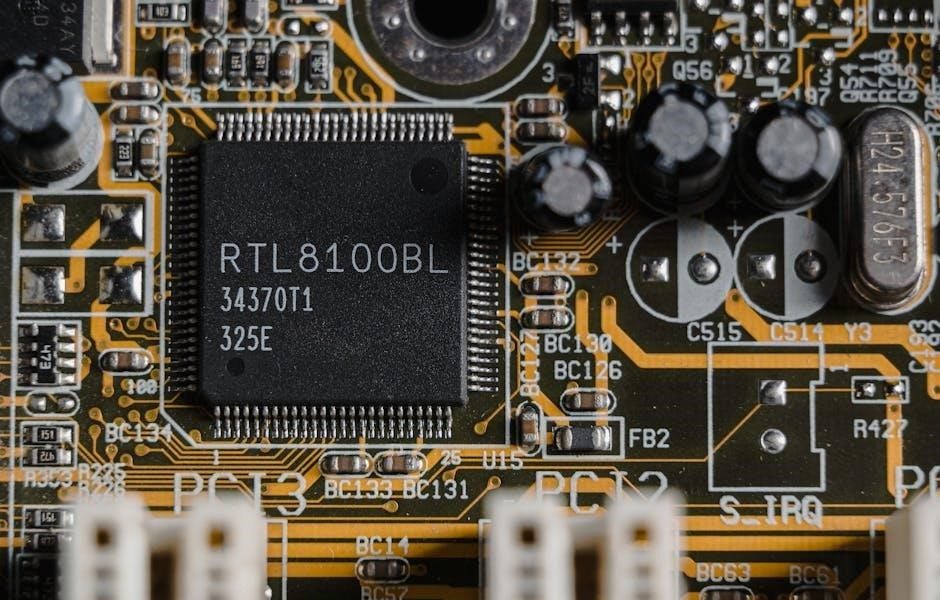
computer motherboard parts and functions pdf
The motherboard is the main circuit board connecting all hardware components, acting as the communication bridge between CPU, RAM, storage devices, and expansion cards. Available in various form factors like ATX, Micro-ATX, and Mini-ITX, it ensures compatibility and optimal system performance.
1.1 Definition and Purpose
The motherboard is the main circuit board of a computer, serving as the primary platform for connecting and supporting all hardware components. It holds the CPU, RAM, expansion cards, and storage devices, enabling communication between them. The motherboard acts as a central hub, allowing data and power to flow between components. Its purpose is to provide a compatible and efficient environment for all parts to function together, ensuring optimal system performance and scalability.
1.2 Importance in Computer Systems
The motherboard is crucial as it integrates all components, ensuring seamless communication and functionality. It connects the CPU, RAM, storage, and peripherals, enabling data transfer and power distribution. Without a motherboard, no component can operate or communicate, making it indispensable. Its design and capabilities directly impact system performance, scalability, and upgradeability, making it the backbone of any computer system. A reliable motherboard ensures stability and efficiency, supporting overall system reliability and user productivity in various computing tasks and applications.
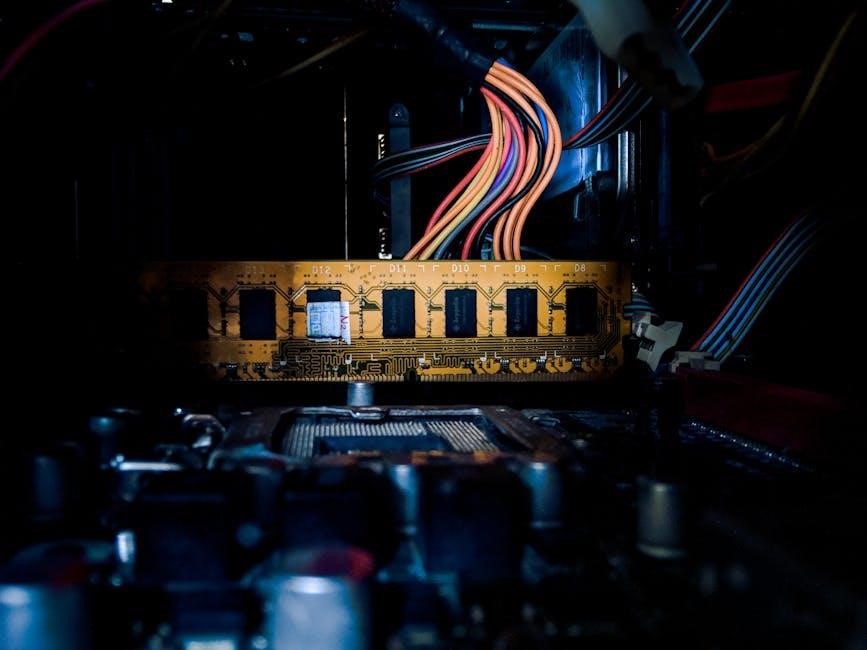
Main Components of the Motherboard
The motherboard features key components like the CPU socket, chipset, RAM slots, and storage connectors, enabling connectivity and functionality for processors, memory, and peripherals. These elements ensure optimal performance and scalability, forming the core of a computer system. Each component plays a vital role in data processing, storage, and system operation, making the motherboard a central hub for all hardware interactions.
2.1 CPU Socket
The CPU socket is a critical component where the processor is installed, enabling communication between the CPU and motherboard. It supports various processor types, such as AMD AM4 or Intel LGA 1200, ensuring compatibility and optimal performance. Proper installation and alignment are essential to avoid damage. Even compatible CPUs may require a BIOS update for full functionality, highlighting the socket’s role in system integration and operational efficiency. Its design varies by processor family, making it a key factor in motherboard selection for specific builds and upgrades.
2.2 Chipset
The chipset acts as the motherboard’s nerve center, managing data flow between the CPU, RAM, and peripherals. It consists of a northbridge and southbridge, coordinating tasks like memory access, I/O operations, and GPU communication. The chipset determines compatibility with specific processors and components, influencing overall system performance. It also impacts expandability through features like USB ports, SATA connectors, and PCIe slots. Updating the chipset drivers ensures optimal functionality, making it a crucial element for maintaining system efficiency and hardware compatibility.
2.3 RAM Slots
RAM slots are where memory modules are inserted, enhancing system performance by providing temporary data storage for the CPU. They support various RAM types like DDR3, DDR4, and DDR5, with compatibility determined by the motherboard. Dual-channel configurations boost memory bandwidth, and proper installation involves aligning notches to prevent damage. The maximum RAM capacity varies, typically ranging from 16GB to 128GB, ensuring flexibility for upgrades and optimizing performance in tasks like gaming and video editing.
2.4 Storage Connectors (SATA Ports)
SATA ports are essential for connecting storage devices like hard drives and SSDs to the motherboard. They support high-speed data transfer, with SATA 3.0 offering up to 6 Gbps. Modern motherboards typically include 4-8 SATA ports, enabling multiple storage configurations. These ports are backward compatible with older SATA devices, ensuring flexibility. They are crucial for installing operating systems, programs, and data, making them indispensable for system functionality and storage expansion.
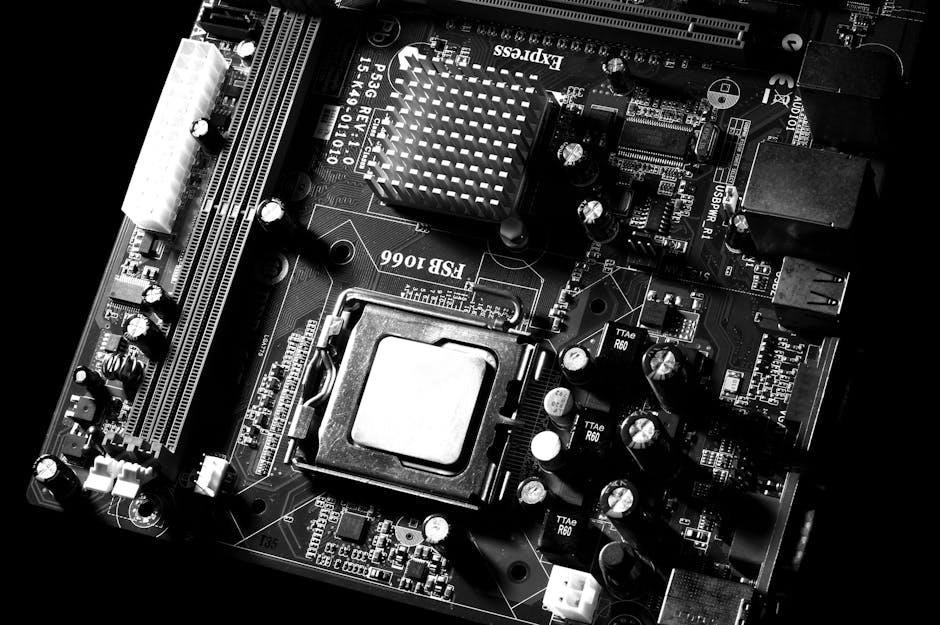
Power Delivery System
The power delivery system ensures stable power distribution to all components, crucial for system stability and performance. It includes VRMs and power connectors like ATX and EPS, delivering clean power efficiently.
3.1 Voltage Regulator Module (VRM)
The Voltage Regulator Module (VRM) is a critical component of the motherboard’s power delivery system. It converts power from the PSU to the specific voltage required by the CPU and other components, ensuring stable and efficient power distribution. The VRM consists of power MOSFETs, inductors, and capacitors, which work together to regulate voltage and filter out noise. This module is essential for maintaining system stability, especially under heavy CPU loads, and prevents voltage fluctuations that could damage components. Proper VRM design and cooling are vital for optimal performance and longevity.
3.2 Power Connectors (ATX, EPS)
Power connectors like ATX and EPS are essential for delivering power to the motherboard and its components. The ATX connector, typically a 24-pin plug, provides power to the motherboard’s core systems, while the EPS (8-pin) connector supplies dedicated power to the CPU. These connectors ensure stable power delivery, supporting the system’s overall performance and preventing power-related issues. Proper connection of these cables is critical for reliable operation and optimal system functionality.
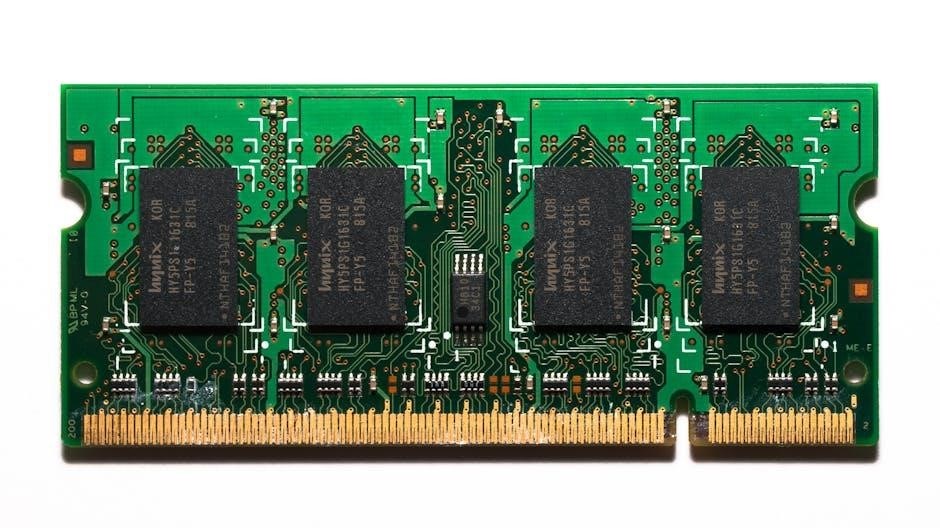
Expansion and Connectivity
Expansion and connectivity options on a motherboard include PCIe slots, PCI slots, and USB ports, enabling users to add graphics cards, sound cards, and other peripherals for enhanced functionality.
4.1 PCIe Slots
PCIe (Peripheral Component Interconnect Express) slots are high-speed expansion ports on motherboards, primarily used for graphics cards, sound cards, and network cards. They support various sizes, such as x16, x8, and x4, catering to different hardware needs. PCIe slots are backward-compatible, allowing older cards to function in newer systems. Modern motherboards often feature PCIe 5.0 or 6.0, offering faster data transfer speeds for enhanced performance. These slots are essential for upgrading and customizing system capabilities, ensuring optimal functionality and future scalability.
4.2 PCI Slots
PCI (Peripheral Component Interconnect) slots are older expansion ports on motherboards, used for installing hardware like sound cards, network cards, and modems. Operating at 33 MHz with a 32-bit bus, they are slower than PCIe slots but remain compatible with legacy devices. While largely replaced by PCIe in modern systems, some motherboards still include PCI slots for backward compatibility, ensuring support for older expansion cards and maintaining flexibility for users with specific hardware needs.
4.3 USB and Other Expansion Ports
USB (Universal Serial Bus) ports are essential for connecting external devices like keyboards, mice, flash drives, and printers. Modern motherboards feature multiple USB 2.0 and 3.0 ports, offering faster data transfer speeds up to 5 Gbps. Additionally, other expansion ports such as PS/2 for legacy peripherals or dedicated audio jacks enhance connectivity. These ports provide versatile options for users to connect a wide range of peripherals, ensuring compatibility and convenience in both modern and older systems.
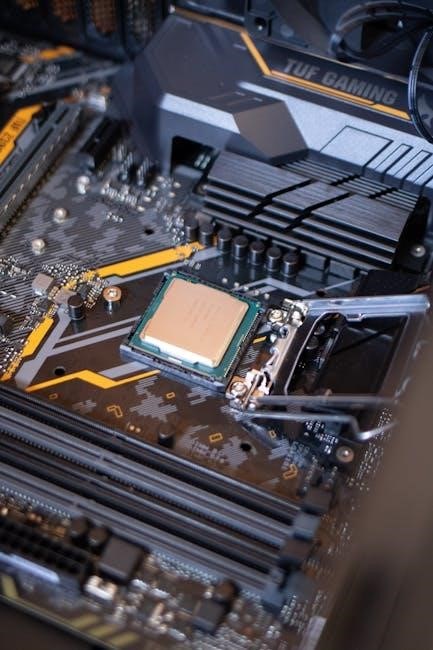
Input/Output Panel
The I/O panel provides external ports for connecting peripherals, including USB, HDMI, Ethernet, and audio jacks, ensuring seamless communication between the computer and external devices.
5.1 External Ports (USB, HDMI, Ethernet)
External ports on the motherboard enable connectivity to peripherals and devices. USB ports support data transfer and device charging, while HDMI ports provide high-definition video output. Ethernet ports offer wired network connections, ensuring reliable internet access. These ports are essential for connecting keyboards, mice, monitors, and network cables, facilitating communication between the computer and external devices. They enhance functionality and user convenience, catering to diverse computing needs.
5.2 Audio Jacks and Other Connectors
Audio jacks provide connectivity for speakers, headphones, and microphones, enabling audio input and output. Additional connectors like SPDIF and optical ports support high-quality digital audio. These connectors enhance multimedia capabilities, allowing users to enjoy immersive sound and manage audio peripherals efficiently. They are crucial for multimedia applications, ensuring seamless integration with sound systems and other audio devices, thereby enriching the overall computing experience.
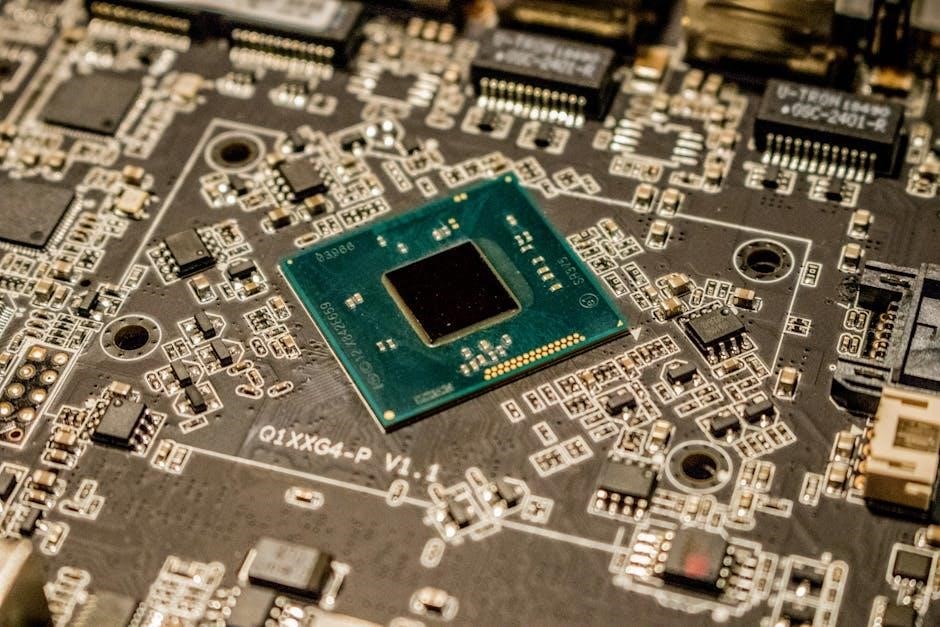
Internal Connectors
Internal connectors link essential components like fans, front panels, and storage devices to the motherboard, ensuring proper system operation and connectivity for internal hardware and peripherals.
6.1 Fan Headers
Fan headers are connectors on the motherboard that power and control case and CPU fans. They provide PWM or DC voltage control, allowing for adjustable fan speeds to optimize cooling and noise levels. Properly connecting fans to these headers ensures efficient thermal management and system stability, especially during high-performance tasks. Modern motherboards often include multiple fan headers for flexible configuration and enhanced cooling solutions.
6.2 Front Panel Connectors
Front panel connectors link the motherboard to the computer’s front-facing components, such as power buttons, reset switches, and LED indicators. These connectors enable user interaction, including turning the system on/off and monitoring activity through LEDs. They also support front panel USB ports for convenient peripheral connections. Properly connecting these ensures seamless functionality and enhances user experience by providing easy access to essential controls and ports.
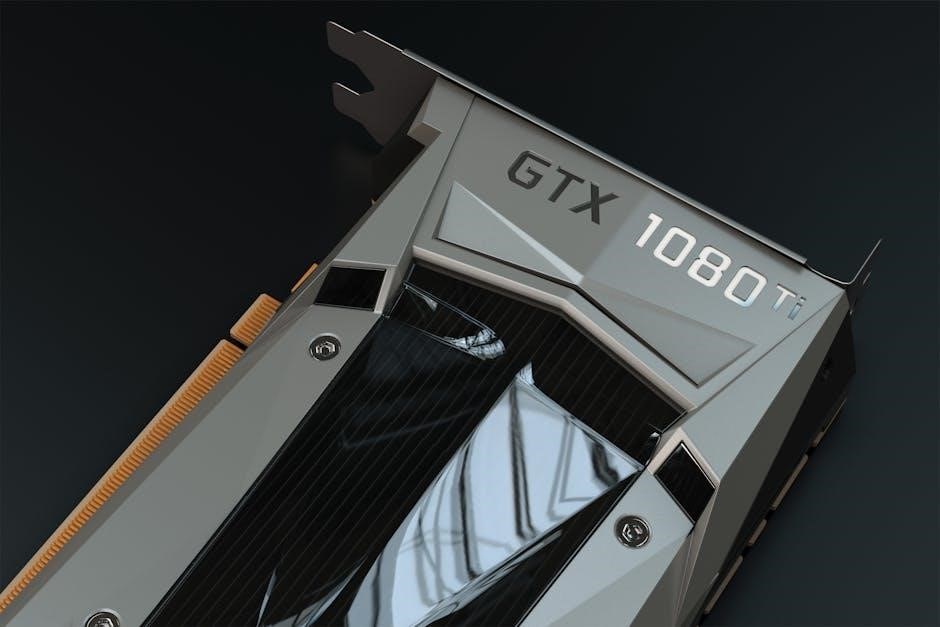
Cooling and Thermal Management
Cooling systems, such as MOSFET heatsinks and chipset cooling solutions, ensure efficient heat dissipation, maintaining optimal temperatures for stable performance and longevity of components.
7.1 MOSFET Heatsinks
MOSFET heatsinks are crucial for dissipating heat generated by power MOSFETs, ensuring stable voltage regulation. They are typically made of aluminum or copper, designed to maximize surface area for efficient cooling. These heatsinks are essential for maintaining optimal temperatures, especially during high-power operations, preventing thermal throttling and component failure. Proper heatsink design and installation are vital for reliable system performance and longevity of the power delivery components on the motherboard.
7.2 Chipset Cooling Solutions
Chipset cooling solutions are designed to manage heat generated by the chipset, ensuring stable data flow and system performance. Passive cooling methods, such as heatsinks, are commonly used, while active cooling with fans is employed in high-performance systems. These solutions prevent overheating, which can lead to instability or component failure. Advanced chipsets may require additional cooling measures, such as heatpipes or liquid cooling, to maintain optimal temperatures and ensure reliable operation across various computing workloads.
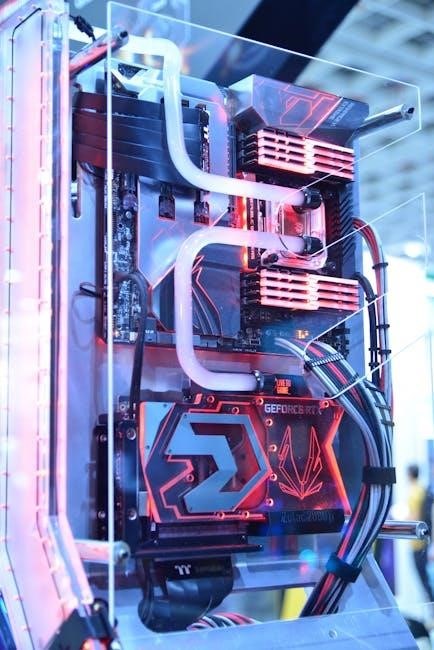
Motherboard Form Factors
Motherboard form factors define the size and layout, determining compatibility with cases and components. Common types include ATX, Micro-ATX, and Mini-ITX, each suited for different PC builds.
8.1 ATX
ATX (Advanced Technology eXtended) is the most common motherboard form factor, measuring 305mm x 244mm. It offers extensive expansion options, including multiple PCIe slots, RAM slots, and storage connectors. Designed for optimal airflow and cable management, ATX boards are ideal for gaming PCs, workstations, and high-performance systems. They feature a rear I/O panel for easy access to ports, making them versatile for both basic and advanced builds. Their popularity stems from balanced functionality and upgradeability.
8.2 Micro-ATX
Micro-ATX motherboards measure 244mm x 244mm, offering a compact yet powerful solution. They support essential features like dual-channel RAM, PCIe slots for graphics cards, and multiple storage connectors. Ideal for budget-friendly builds and small-form-factor PCs, Micro-ATX boards balance functionality with space efficiency; While they have fewer expansion slots than ATX, they remain versatile for everyday computing, gaming, and home office setups, providing excellent value for cost-conscious users seeking reliable performance in a smaller footprint.
8.3 Mini-ITX
Mini-ITX motherboards are the smallest, measuring 170mm x 170mm, designed for ultra-compact systems. They support single-phase power designs, limited expansion slots, and essential connectors for storage and memory. Ideal for embedded systems, media centers, and small-form-factor PCs, Mini-ITX boards prioritize space efficiency without sacrificing core functionality. They are perfect for users needing a portable, energy-efficient solution, though they may lack high-end features, making them best suited for basic computing tasks and specialized applications requiring minimal hardware.
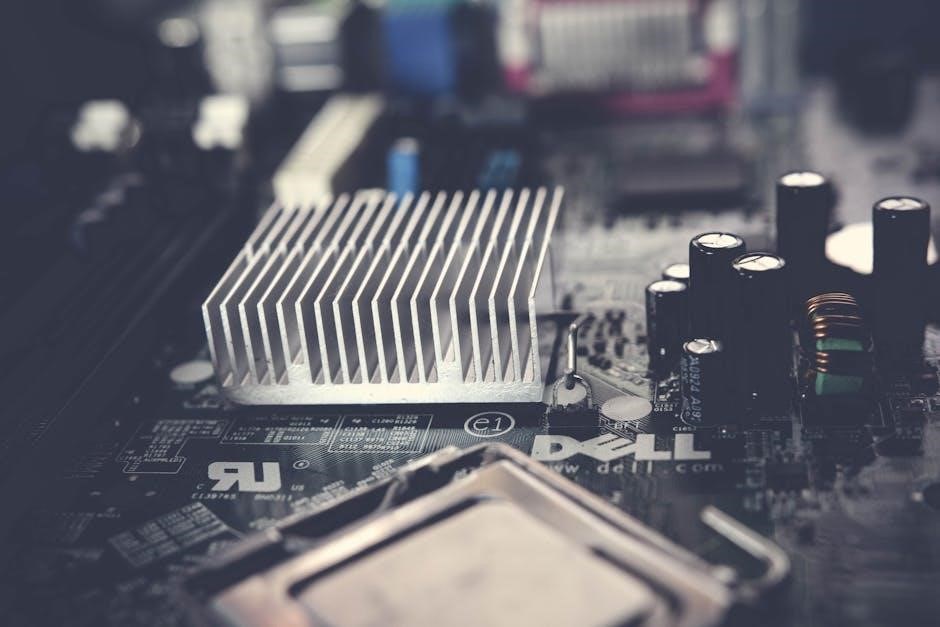
Firmware and BIOS/UEFI
Firmware and BIOS/UEFI are essential for system initialization and hardware communication. Firmware is permanent software embedded in hardware, while BIOS/UEFI manages boot processes and system configuration.
9.1 BIOS/UEFI Functions
The BIOS (Basic Input/Output System) or UEFI (Unified Extensible Firmware Interface) is firmware that initializes hardware and manages boot processes. It provides a configuration interface for setting boot priority, time, and passwords. Key functions include detecting hardware components, enabling secure boot, and offering diagnostic tools. BIOS/UEFI updates are crucial for adding new features, improving compatibility, and fixing bugs. Modern UEFI systems offer advanced features like faster boot times and better security compared to traditional BIOS.
9.2 Updating Firmware
Updating firmware ensures the BIOS/UEFI operates with the latest features and security patches. The process typically involves downloading the motherboard manufacturer’s official update tool and the specific firmware version. It requires careful execution to avoid hardware damage. Most updates can be done via USB within the BIOS/UEFI interface or through a Windows-based utility. Proper preparation, including backing up data and ensuring a stable power supply, is essential to prevent failures during the update process.
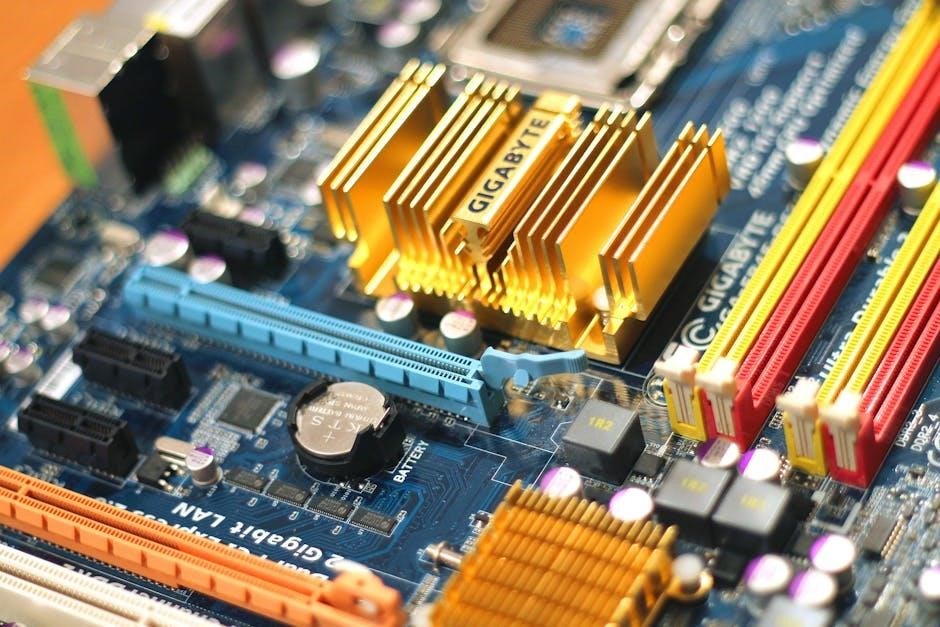
Troubleshooting Common Issues
Troubleshooting common motherboard issues involves identifying faulty components and diagnosing power or connectivity problems. Tools like diagnostic software and BIOS/UEFI checks help resolve these issues efficiently.
10.1 Identifying Faulty Components
Identifying faulty components on a motherboard involves visual inspection and diagnostic tools. Look for physical damage, burn marks, or bulging capacitors. Use software tools to test component functionality; Common issues include failing VRMs, defective RAM slots, or malfunctioning PCIe slots. Symptoms like system instability or failure to boot can indicate faulty components. Replacing these parts is crucial to restore system functionality and prevent further damage. Proper diagnostic techniques ensure accurate identification and resolution of hardware issues. Regular checks help maintain system reliability and performance over time. Always use compatible replacement parts for optimal results.
10.2 Diagnosing Power Issues
Diagnosing power issues on a motherboard involves checking the power connectors and voltage regulator module. Use a multimeter to test voltage levels at ATX and EPS connectors. Ensure all power cables are securely connected and not damaged. Faulty VRMs or power phases can cause instability. Symptoms like random shutdowns or failure to power on indicate power issues. Cleaning corrosion or replacing faulty components often resolves these problems. Proper diagnostic tools help identify and address power-related issues effectively, ensuring stable system operation and preventing hardware damage. Regular power supply checks are essential for maintaining system reliability. Always verify power specifications for compatibility.
The motherboard is the backbone of a computer, integrating all components for smooth operation. Understanding its parts and functions is crucial for building, upgrading, and maintaining systems effectively.
11.1 Summary of Key Points
The motherboard is the main circuit board connecting all hardware components, acting as the communication bridge between the CPU, RAM, storage devices, and expansion cards. It houses essential parts like the CPU socket, chipset, RAM slots, and PCIe slots, enabling system functionality. Understanding its components and functions is crucial for building, upgrading, and troubleshooting computers effectively. Proper selection and maintenance of the motherboard ensure optimal performance, stability, and future-proofing of a computer system.
11.2 Importance of Motherboard in Modern Computing
The motherboard is the backbone of modern computing, enabling seamless communication between all hardware components. It plays a pivotal role in determining system performance, scalability, and compatibility with advanced technologies. By integrating cutting-edge features like high-speed processors, GPUs, and storage solutions, the motherboard drives innovation and efficiency. Its role in power management and thermal regulation ensures reliable operation, making it indispensable for both basic and high-performance computing applications in today’s digital landscape.
Related Posts

costanzo physiology pdf free download
Get instant access to Costanzo Physiology PDF. Download the full textbook for free and start learning today!

fundamentals of financial accounting fred phillips pdf
Get Fred Phillips Financial Accounting PDF for free and learn fundamentals of accounting at fihimafihi.com

gcf and lcm worksheet pdf
Download free GCF and LCM worksheets in PDF format for math practice